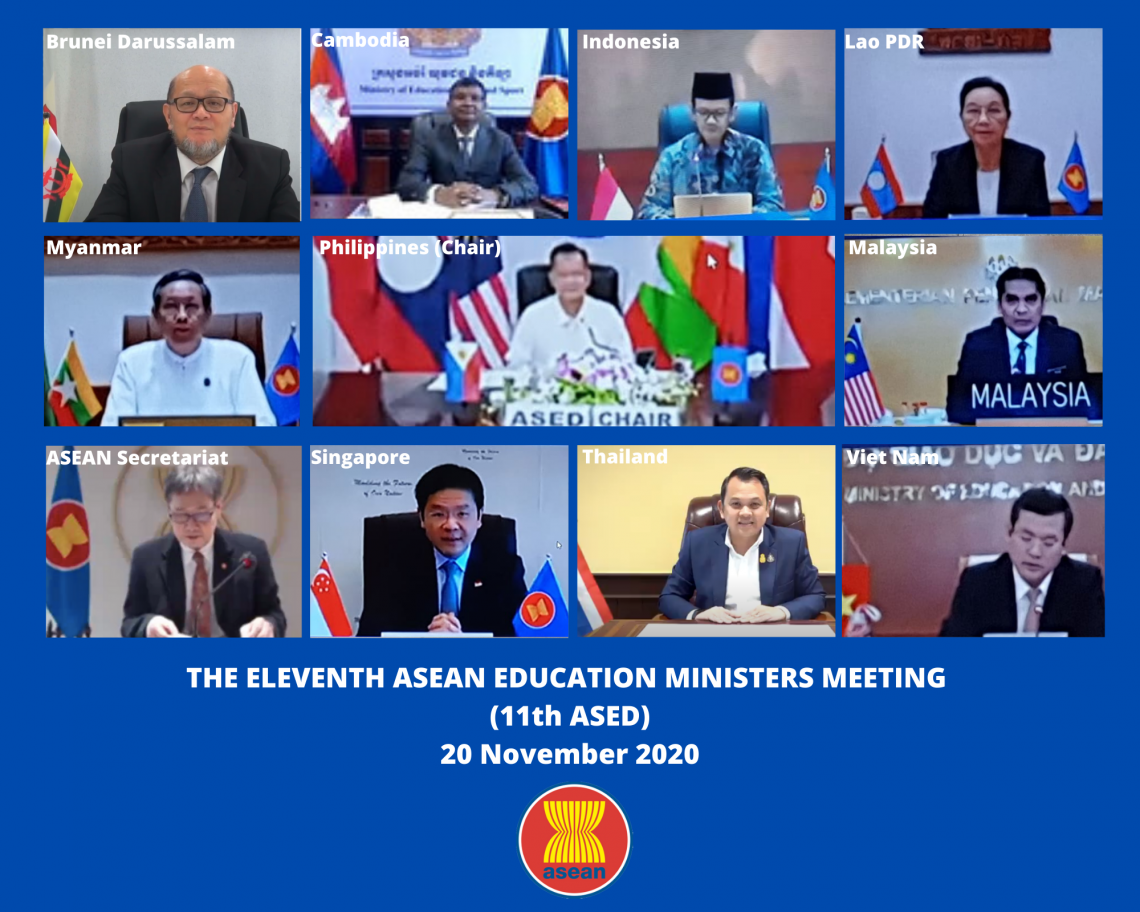MANILA, 27 November 2020 – ASEAN Education Ministers and senior officials participated in the Fifteenth ASEAN Senior Officials Meeting on Education (15th SOM-ED) on 18 November and the Eleventh ASEAN Education Ministers Meeting (11th ASED) on 20 November. Both meetings were convened online.
The Director-General of the Philippines’ Technical Education and Skills Development Authority Isidro S. Lapeña chaired the 11th ASED on behalf of ASED Chair Leonor Magtolis Briones, Secretary of Education of the Philippines.
Themed “Transforming Education the ASEAN Way: Forging Partnerships in the Age of Global Disruptions,” the meeting highlighted the exchange of national experiences in grappling with COVID-19 related challenges amongst ASEAN Education Ministers. The Ministers believed that the pandemic can be used as an impetus to accelerate digital transformation and build robust and future-proof education systems.
In his statement, Secretary-General of ASEAN Dato Lim Jock Hoi said, “despite this crisis, education cannot wait. Education simply cannot stop, particularly for learners from disadvantaged backgrounds who may fall even further behind.’’
‘’The COVID-19 pandemic likewise serves as a reminder to bolster our education systems, with a view to empowering our learners with the skills and competencies to make them resilient and future-ready. Should they ever have to face another shock of this scale, they will be prepared,” he added.
The Ministers adopted a Joint Statement representing the sector’s commitment to promote competitive human resources and help rebuild the region post-pandemic through education. The Statement reflects the sector’s resolve to implement the Roadmap of the ASEAN Declaration on Human Resources Development for the Changing World of Work and the ASEAN Comprehensive Recovery Framework (ACRF), as well as the upcoming initiatives of the ASEAN Technical and Vocational Education and Training (TVET) Council. Further, the Ministers pledged to design a post-2020 education work plan anchored on the concept of lifelong learning.
Undersecretary of the Philippines’ Department of Education Jesus Lorenzo R. Mateo chaired the 15th SOM-ED . Senior officials assessed the sector’s progress against the ASEAN Work Plan on Education 2016-2020 and agreed on the next steps to finalise the succeeding five-year work plan.
As education is vital to the region’s post-COVID rebuilding efforts, senior officials also discussed the education-focused initiatives included in the ACRF’s implementation plan.
The Philippines, as the new Chair of the ASEAN TVET Council, announced its intention to convene a meeting in early 2021 to discuss the
Council’s future work and programmes.
Senior officials shared the response efforts and strategies undertaken by ASEAN Member States (AMS) to tackle the impacts of COVID-19 on education. The Secretariats of the ASEAN University Network and the Southeast Asian Ministers of Education Organisation also contributed to the discussion.
Across the region, AMS are reopening schools in a safe and phased manner. Guidelines on school reopening are in line with COVID-19 health and safety protocols to ensure the welfare of students, teachers and communities. AMS are also taking steps to provide psychosocial support to students in an effort to address students’ mental health and well-being.
In situations where schools remain closed, distance education is delivered through online and offline approaches, including e-learning platforms, open educational resources, radio and television. In addition, AMS are expanding students’ access to internet and digital devices, providing food subsidies and cash assistance to low-income families, and building the capacity of teachers in providing distance education.
- ABOUT ASEANThe Association of Southeast Asian Nations, or ASEAN, was established on 8 August 1967 in Bangkok, Thailand, with the signing of the ASEAN Declaration (Bangkok Declaration) by the Founding Fathers of ASEAN: Indonesia, Malaysia, Philippines, Singapore and Thailand. Brunei Darussalam joined ASEAN on 7 January 1984, followed by Viet Nam on 28 July 1995, Lao PDR and Myanmar on 23 July 1997, and Cambodia on 30 April 1999, making up what is today the ten Member States of ASEAN.Menu
- WHAT WE DO
ASEAN organs always strive to achieve ASEAN’s goals and objectives, the Secretary-General of ASEAN and the ASEAN Secretariat shall be functioned as coordinating Secretariat to help facilitate effective decision-making withing and amongst ASEAN bodies. In addition, each Member State shall appoint a Permanent Representative to liaise with Secretary-General of ASEAN and the ASEAN Secretariat
Menu - WHO WE WORK WITH
ASEAN shall develop friendly relations and mutually beneficial dialogues, cooperation and partnerships with countries and sub-regional, regional and international organisations and institutions. This includes external partners, ASEAN entities, human rights bodies, non-ASEAN Member States Ambassadors to ASEAN, ASEAN committees in third countries and international organisations, as well as international / regional organisations.
Menu - OUR COMMUNITIES
The rodmap for an ASEAN Community (2009-2015) was declared by the leaders in 2009. The ASEAN Community, anchored on three community pillars: Political-Security Community, Economic Community, Socio-Cultural Community was launched in 2015. The ASEAN 2025: Forging Ahead Together was introduced in 2015 as a Post-2015 Vision. It comprises the ASEAN Community Vision 2025, the ASEAN Political-Security Community Blueprint 2025, the ASEAN Economic Community Blueprint 2025 and the ASEAN Socio-Cultural Community Blueprint 2025
Menu - SITEMAP





